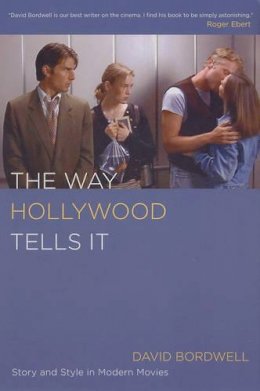12%OFF

Stock image for illustration purposes only - book cover, edition or condition may vary.
The Way Hollywood Tells It: Story and Style in Modern Movies
David Bordwell
€ 38.99
€ 34.17
FREE Delivery in Ireland
Description for The Way Hollywood Tells It: Story and Style in Modern Movies
Paperback. Hollywood moviemaking is one of the constants of American life, but how much has it changed since the glory days of the big studios? This book argues that the principles of visual storytelling created in the studio era are alive and well. Num Pages: 309 pages, 157 b/w photographs. BIC Classification: APF. Category: (P) Professional & Vocational. Dimension: 228 x 154 x 17. Weight in Grams: 586. Story and Style in Modern Movies. 309 pages, 157 b/w photographs. Hollywood moviemaking is one of the constants of American life, but how much has it changed since the glory days of the big studios? This book argues that the principles of visual storytelling created in the studio era are alive and well. Cateogry: (P) Professional & Vocational. BIC Classification: APF. Dimension: 228 x 154 x 17. Weight: 600.
Hollywood moviemaking is one of the constants of American life, but how much has it changed since the glory days of the big studios? David Bordwell argues that the principles of visual storytelling created in the studio era are alive and well, even in today's bloated blockbusters. American filmmakers have created a durable tradition-one that we should not be ashamed to call artistic, and one that survives in both mainstream entertainment and niche-marketed indie cinema. Bordwell traces the continuity of this tradition in a wide array of films made since 1960, from romantic comedies like Jerry Maguire and Love Actually to more imposing efforts like A Beautiful Mind. He also draws upon testimony from writers, directors, and editors who are acutely conscious of employing proven principles of plot and visual style. Within the limits of the "classical" approach, innovation can flourish. Bordwell examines how imaginative filmmakers have pushed the premises of the system in films such as JFK, Memento, and Magnolia. He discusses generational, technological, and economic factors leading to stability and change in Hollywood cinema and includes close analyses of selected shots and sequences. As it ranges across four decades, examining classics like American Graffiti and The Godfather as well as more recent success like The Lord of the Rings: The Two Towers, this book provides a vivid and engaging interpretation of how Hollywood moviemakers have created a vigorous, resourceful tradition of cinematic storytelling that continues to engage audiences around the world.
Product Details
Publisher
University of California Press
Number of pages
309
Format
Paperback
Publication date
2006
Condition
New
Weight
584g
Number of Pages
309
Place of Publication
Berkerley, United States
ISBN
9780520246225
SKU
V9780520246225
Shipping Time
Usually ships in 4 to 8 working days
Ref
99-2
About David Bordwell
David Bordwell is Jacques Ledoux Professor of Film Studies and Hilldale Professor of Humanities at the University of Wisconsin-Madison. Among his books are Figures Traced in Light: On Cinematic Staging, Film History: An Introduction (with Kristin Thompson, 2002), Planet Hong Kong: Popular Cinema and the Art of Entertainment, and On the History of Film Style.
Reviews for The Way Hollywood Tells It: Story and Style in Modern Movies
"David Bordwell is our best writer on the cinema. He is deeply informed about films, he loves them, and he writes about them with a clarity and perception that makes the prose itself a joy to read. Because he sees movies so freshly and deeply he isn't deceived by the usual categories and finds excellence and experiment in unexpected places." - Roger Ebert "There is no shortage of scholarly literature on contemporary Hollywood, but none of it lives up to the standards set by Bordwell here. No one else has this range, depth, sophistication or authority. More remarkable still, Bordwell pulls this off with remarkable lightness of touch." - Murray Smith, University of Kent"
